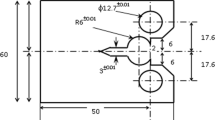Abstract
The effects of varying finish rolling temperature (FRT) and cooling rate on the mechanical properties of hot rolled plates of an experimental low-alloy Ti-V steel were studied. Fracture toughness was evaluated for various types of specimens at slow and high deformation rates. However, the transition temperatures determined by the various tests do not always correlate. Therefore, it is recommended that fracture toughness be evaluated by both static and dynamic testing. Following a low cooling rate, the best plate properties are obtained at the lowest FRT in the austenite-ferrite range, although occurrence of delaminations at this temperature may be detrimental for specific applications. Higher cooling rates produce higher strength but lower toughness than lower cooling rates in plates with the same FRT.
Similar content being viewed by others
References
T. Tanaka:Intern. Metal Reviews, 1981, vol. 4, pp. 185–212.
S. T. Rolfe and J.M. Barsom:Fracture and Fatigue Control in Structures, Prentice-Hall, NJ, 1977.
R. O. Ritchie, B. Francis, and W. L. Server:Metall. Trans. A, 1976, vol. 7A, pp. 831–38.
B. Dogan, L. E. Collins, and J. D. Boyd:Metall. Trans. A, in press.
ASTM-E813,Standard Test Method for J, Ic a Measure of Fracture Toughness, American Society for Testing and Materials, 1981.
ASTM-E399,Standard Test Method for Plane-Strain Fracture Toughness of Metallic Materials, American Society for Testing and Materials, 1981.
BS5762,Methods for Crack Opening Displacement (COD) Testing, British Standards Institution, 1979.
B Faucher and W. R. Tyson: inElastic-Plastic Fracture Test Meth- ods: The User's Experience, ASTM STP 856, E. T. Wessel and F. J. Loss, eds., American Society for Testing and Materials, 1985, pp. 278-93.
R. O. Ritchie, J. F. Knott, and J. R. Rice:J. Mechanics and Physics of Solids, 1973, vol. 21, pp. 395–410.
B. Faucher and W. R. Tyson: Presented at 19th National Symposium on Fracture Mechanics, Boulder, CO, June 1985.
J.M. Barsom and S.T. Rolfe:Impact Testing of Metals, ASTM STP 466, American Society for Testing and Materials, 1970, pp. 281–302.
B. Faucher:J. Mater. Eng., 1987, vol. 9(1), pp. 19–24.
G.A. Knorovsky:Fracture Mechanics: Sixteenth Symposium, ASTM STP 868, M.F. Kanninen and A.T. Hopper, eds., Ameri- can Society for Testing and Materials, Philadelphia, PA, 1985, pp. 569–96.
K. Ando, H. Matsushita, S. Fujibayashi, and N. Ogura:Zairyo, April 1985, vol. 34, pp. 388–93.
J. Katsuta, M. Nakashima, and K. Kawano:Rep. Fac. Eng., Nagasaki Univ., Japan, July 1985, vol. 15, pp. 39–44.
D.B. McCutcheon, J.D. Embury, and G. Burger: Presented at Japan-Canada Seminar on Secondary Steelmaking, Tokyo, Japan, Dec. 1985.
Author information
Authors and Affiliations
Rights and permissions
About this article
Cite this article
Faucher, B., Dogan, B. Evaluation of the fracture toughness of hot-rolled low-alloy Ti-V plate steel. Metall Trans A 19, 505–516 (1988). https://doi.org/10.1007/BF02649265
Received:
Issue Date:
DOI: https://doi.org/10.1007/BF02649265




